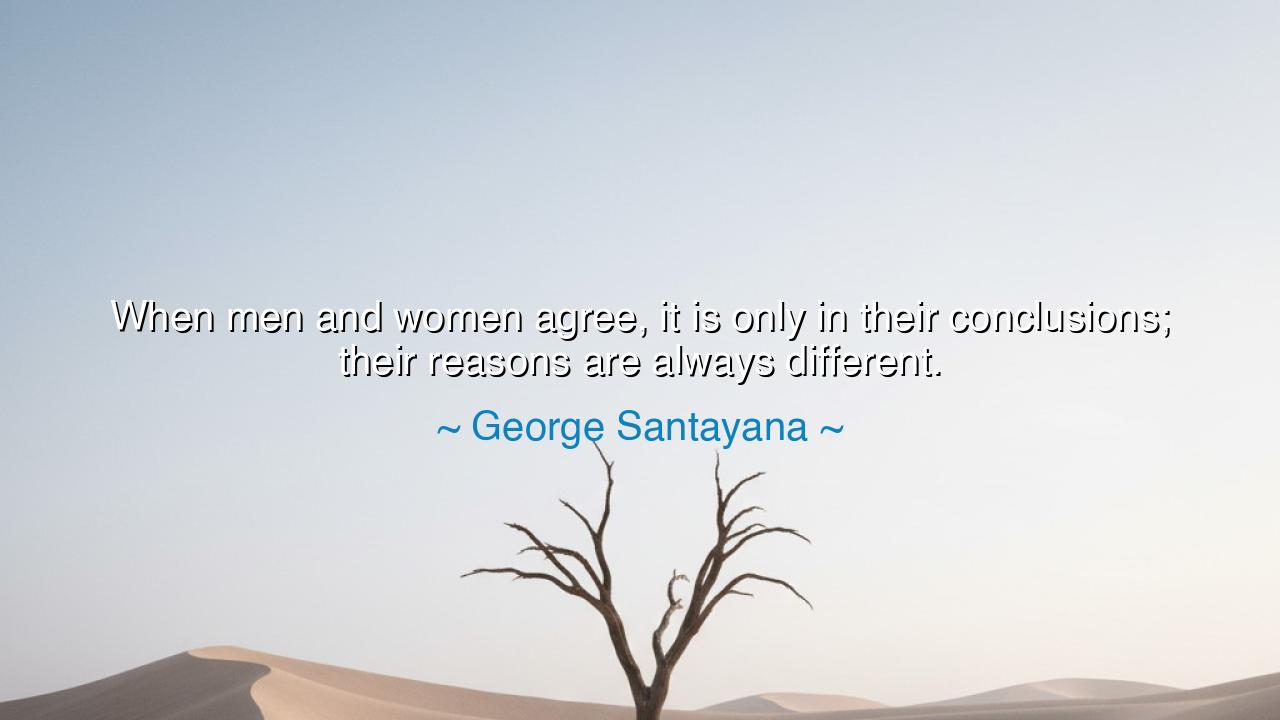
When men and women agree, it is only in their conclusions; their
When men and women agree, it is only in their conclusions; their reasons are always different.






The words of George Santayana, “When men and women agree, it is only in their conclusions; their reasons are always different,” are not a jest of gender, but a meditation upon the profound duality that dwells within the human spirit. Beneath his elegant irony lies a truth that transcends the differences of man and woman—it is the truth that harmony in life often conceals the hidden complexity of thought. Santayana, a philosopher of perception and spirit, spoke not as one mocking division, but as one who saw that the unity of humanity is woven from difference, that men and women may walk toward the same destination, but along separate roads of reason, intuition, and experience.
In his age—the late nineteenth and early twentieth centuries—Santayana watched the world awaken to modern ideas of individuality and equality. Yet he also perceived that though men and women were beginning to meet as equals in the public realm, they still interpreted the world through different lenses. The man, he observed, tended toward abstraction and logic; the woman, toward intuition and feeling. These were not flaws, but natural modes of perception, born of centuries of experience and nature’s design. When they agreed, therefore, it was a sign not of identical minds, but of different minds arriving at shared wisdom. The same truth seen from two heights becomes richer, not weaker, for the difference in its vision.
The ancients too understood this duality. Plato, in his dialogues, spoke of the masculine and feminine principles as the two halves of the soul—one reasoning, one receptive; one firm, one nurturing. In the union of these forces, he saw the source of harmony. Santayana’s insight echoes this ancient wisdom: that agreement between man and woman is not the flattening of difference, but the convergence of opposites. When they reach the same conclusion, their unity is not mechanical, but alchemical. It is the meeting of reason and intuition, mind and heart, which together reveal truths neither could discover alone.
Consider the life of Marie and Pierre Curie, two souls who changed the face of science. Together they uncovered the mysteries of radioactivity, but their ways of thought were distinct. Pierre’s was methodical, mathematical, grounded in the laws of matter. Marie’s was imaginative, intuitive, driven by deep emotional conviction. They shared discoveries because their spirits complemented one another. Their agreement in discovery was a harmony of difference—each seeing a different facet of truth, each strengthening the other. Theirs was not the cold alliance of intellects, but the sacred marriage of mind and soul.
Santayana’s observation also speaks to the nature of understanding itself. Agreement between men and women—or between any two minds—is never perfect symmetry; it is resonance. It is like two instruments tuned differently, yet playing the same melody. Their notes vibrate with tension and beauty precisely because they are not the same. This is why relationships, partnerships, and even societies flourish when difference is honored rather than erased. Unity that demands sameness is tyranny; unity that celebrates difference is wisdom. The man who insists that others think exactly as he does builds a world of mirrors, not windows. The one who listens to another’s reasoning, even when strange to him, learns to see the world whole.
But there is also a subtle warning in Santayana’s words. Agreement built only on conclusion, without understanding of the reasons beneath it, can be fragile. Two may walk together today but part tomorrow if their harmony is born of convenience, not comprehension. True unity requires not merely arriving at the same answer, but respecting the paths that lead there. This is as true in marriage as in politics, in art as in faith. The wise do not seek to erase difference, but to comprehend it, to see that the contrast between hearts is what gives color to truth.
So let this teaching be passed down: seek harmony through difference, not in spite of it. When you find agreement with another, do not rush to believe that you think alike; instead, rejoice that your diverse souls have found common ground. Listen to the reasons of others, for in their difference lies your completion. As George Santayana reminds us, the balance of man and woman, of logic and feeling, of mind and heart, is the rhythm of life itself. To walk together toward truth, even from different directions, is to fulfill the ancient design of creation: the unity of opposites, the eternal dialogue that makes wisdom possible.






AAdministratorAdministrator
Welcome, honored guests. Please leave a comment, we will respond soon